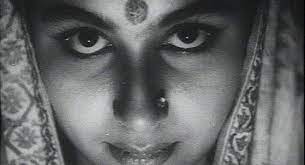Devika Girish at The Current:
 A pair of kohl-lined eyes bores through the screen in the first few moments of Satyajit Ray’s Devi (1960), as the blank visage of a clay idol of Goddess Durga—held in close-up behind the opening credits—acquires bold, painted features. In Hindu myth, Durga and her wrathful avatar, Kali, are both forms of Devi, the all-powerful Mother Goddess. When the camera pulls away from the idol to reveal a village celebration of Durga Puja, the melodic strings of the score giving way to the diegetic din of bells and fireworks, it’s as if the legend of the Mother Goddess has been reified: the world has come into boisterous being around her.
A pair of kohl-lined eyes bores through the screen in the first few moments of Satyajit Ray’s Devi (1960), as the blank visage of a clay idol of Goddess Durga—held in close-up behind the opening credits—acquires bold, painted features. In Hindu myth, Durga and her wrathful avatar, Kali, are both forms of Devi, the all-powerful Mother Goddess. When the camera pulls away from the idol to reveal a village celebration of Durga Puja, the melodic strings of the score giving way to the diegetic din of bells and fireworks, it’s as if the legend of the Mother Goddess has been reified: the world has come into boisterous being around her.
The scene is both an anomaly in Ray’s work, with its gothic shadings, and a kind of signature shot. Often in the Bengali auteur’s lyrical, literary films, a set of curious eyes leads us into a world, and into a nascent point of view. Think of our introduction to Apu in Pather Panchali (1955), Ray’s triumphant debut feature and the first entry in The Apu Trilogy: Apu’s sister, Durga, pries one of his eyes open through a hole in his blanket to wake him up for school.
more here.
